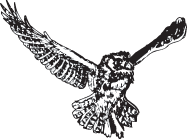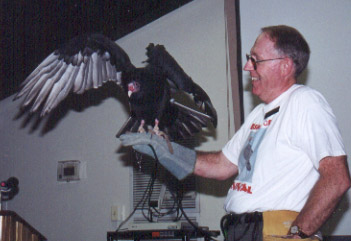

Turkey Vulture Facts
(Cathartes aura: the great cleanser, gold, relating to the red head)
Three very important things to remember about turkey vultures are:
- The turkey vulture's frail bill has a sharp hook at the end for tearing apart its food. You can see through the nasal passage in the beak of a turkey vulture.
- Vultures are one of the very few birds to have an excellent sense of smell. Turkey vultures often find natural gas pipe leaks because ethyl mercaptan -- the unpleasant smell added to natural gas -- is also the odor of rotting flesh (dinner to the vulture).
- Vultures stand with three toes forward and one toe backwards. Their weak feet and short, curved talons are not able to seize prey. The main function of their feet is running on the ground.

Some more vulture facts are:
- Turkey vultures have wing spans up to 6 feet, weights of 3 to 4 pounds. Males and females are similar in size and weight.
- As scavengers, vultures consume huge quantities of carrion from roads, fields and forests. Vultures play an major role in nature's cleanup crew.
- Turkey vultures rarely flap their wings; they hold their wings in a "V" and use the updrafts, thermals, to soar for hours. They usually rock from side to side as they fly at speeds from 15 to 34 miles per hour.
- Vultures are essentially voiceless as they lack a voice box. They are able to make snorting and hissing sounds by blowing air through their noses. They also stomp their feet when warning others to stay away.
- Seen from below, the turkey vulture is a charcoal bird, with silver primary feathers along the trailing edges of its wings.
- Young turkey vultures have black featherless necks and heads (bald). Adult turkey vultures have red featherless necks and heads. Without feathers, their heads appear very small from a distance .
- Turkey vultures are very social birds; they roost together at night (up to 70 birds in a tree) and will search for food together in groups of 3-12.
- Turkey vultures sun themselves by spreading their wings for several minutes before they fly. The sunning provides the turkey vulture with vitamin D and also helps them to increase their body temperature before they try to fly. They usually are late risers, waiting for the sun to warm them and to create thermals so they can circle and fly directly to the food source located the previous day.
- Their only natural defense is to project their vomit or poop. They can do this up to six feet away.
- Turkey vultures are able to eat carrion and contaminated meat due to specialized enzymes and bacteria in their digestive systems. These sky hunters are sometimes called "the flying detox plants."
- Turkey vultures flapping their wings and their rapid movements on a carcass was once thought to be fighting over a carcass, but today it is believed to be a cooperative effort to tear open the tough hides by pulling and tugging in opposite directions.
- Turkey vultures of New York state are migratory in that they migrate south each fall before the winter's snow cover halts the thermals needed for their flight. The following spring they return to nests on cliffs, in logs or stumps or among rocks on the ground. Young hatch with their eyes open and covered with down.
- Turkey vultures' young are dependent on their parents for as long as six months. Adult vultures lay one egg every other year.
- In the early 1900s, the turkey vulture bred only as far north as New Jersey. The development of the interstate highway system, which produced a huge number of road-killed animals, attracted the vulture scavengers north into the New England states.
- There may be a symbiotic relationship between turkey vultures and coyotes. Turkey vultures fly many miles and find animal carcasses with their excellent eyes and sense of smell but are not able tear open the tough skin. Coyotes see the turkey vultures circling their find and tear open up the carcass as they feed on it. After the coyotes are full the turkey vultures are able to feed.
- New world vultures (North and South American vultures) include the turkey vulture, black vulture, California condor, king vulture and Andean condor.
- The new world vultures are related to the storks, herons and ibis. The great blue heron is a cousin to the turkey vulture. Stork/Heron characteristics include: nostrils are perforated, no voice box, naked face, urinating on legs to cool, and full-spread wings in sunning.
- New world vultures are not related to the old world vultures (Asian, African or European vultures) or birds of prey such as the hawks and eagles or owls.
- The Andean condor, a new world vulture, is the largest living flying bird in the world with a 10-to-12-foot wing span and weighing 18 to 33 pounds.
- An extinct new world vulture, Argentavis magnificens, had a wing spread of 23 feet and an estimated weight of 160 to 170 pounds.
- Both new and old world vultures evolved some 50 million years ago. They look alike because of convergent evolution -- they occupy similar niches.